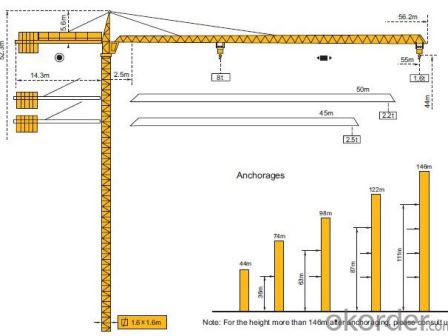This manual has been provided as a reference source. The materials it contains provide technical information, specifications, load charts, and general information about tower cranes.
The information obtained here is not specific to a single manufacturer. Furthermore, none of the information should be used for the erection, dismantling, climbing, operation or maintenance of any tower crane.
This information should be obtained from the manufacturer’s operation manual specific to the type of crane involved.
Typical tower crane dimensions
Tower crane base dimensions
The base support is the part of the tower crane that attaches the tower to the surrounding ground or structure. When a crane is fixed to the ground, it is usually done with reinforced concrete, as well as with piles to extend the support to the bedrock. It is important to hire an engineer to design this tower component.
Tower crane mast dimensions
It is a metal lattice structure with a normally square section, whose main mission is to provide the tower crane with sufficient height. Normally it is formed by lattice modules that facilitate the transport of the crane, the dimension of the main section is determined by the maximum height.
Tower crane section dimensions
The dimensions of the tower crane section vary according to the type of tower crane (Hammerhead, Self-erecting, Flat-top), these are important because it determines the load and lifting capacity of a tower crane, the main sections are the base, which It depends on the working height and the boom that determines the maximum reach.
Tower crane boom dimensions
Typical capacities and dimensions for most tower cranes are:
- Boom length: 60mMaximum
- lifting capacity: 10TFree
- height: 50m, can add up to 200m

Tower Crane Load chart
The lifting capacity of the crane depends on several factors. The limitation for lifting weight begins at the base of the tower crane. Each and every component of the crane affects the lifting capacity of the load.
